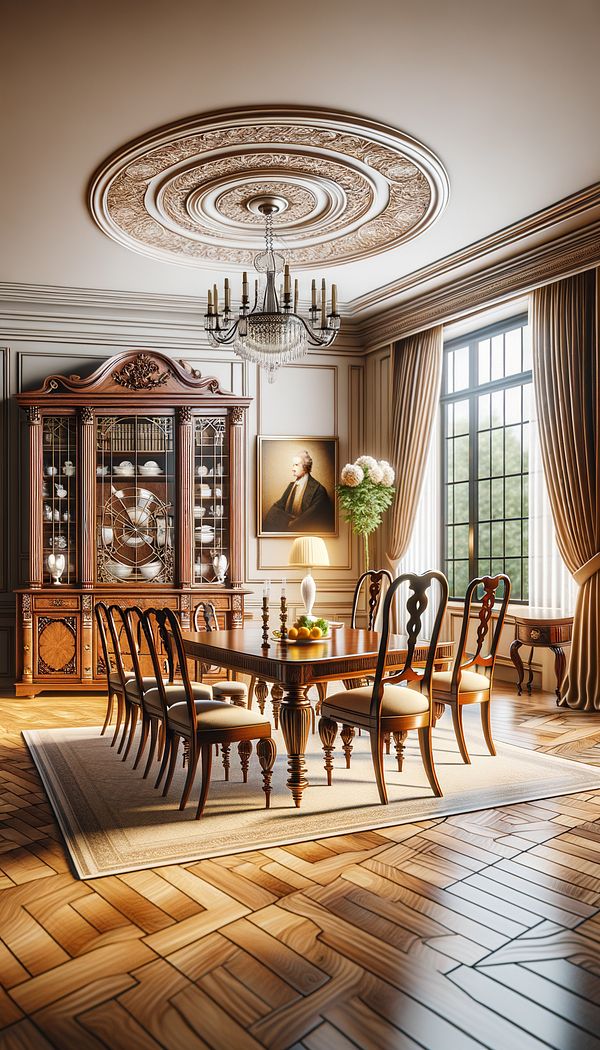What is Sheraton?
Sheraton refers to a classic British furniture style that emerged in the late 18th century.
Description
Sheraton is a distinguished furniture style named after the English furniture designer and maker, Thomas Sheraton, who lived during the late 18th century. Recognizable for its elegance, lightness, and fine craftsmanship, Sheraton furniture epitomizes the refined aesthetics of the Georgian and early Regency periods. This style often features straight lines, contrasting veneers, tapered legs, and the use of classical motifs such as urns, swags, and bellflowers. Unlike its contemporaries, the Sheraton style places a strong emphasis on simplicity and proportion rather than heavy decoration. This style is closely aligned with the principles of neoclassicism, drawing inspiration from ancient Greek and Roman architecture and art. Sheraton furniture typically includes items such as dining chairs, sideboards, bookcases, and writing desks.
The craftsmanship found in Sheraton pieces occurs through skillful joinery and the use of high-quality materials, including mahogany, satinwood, and harewood. Inlays and marquetry, utilizing contrasting woods, are common features that add visual interest without overwhelming the piece's overall simplicity. Today, Sheraton style remains popular among collectors and enthusiasts of traditional British furniture for its timeless elegance and functionality.
Usage
Sheraton furniture is often sought after for traditional or classical interiors, providing an air of sophistication and grace. It's commonly found in settings like historical homes, elegant hotels, and stately offices. Individuals who appreciate historic design narratives and timeless beauty are drawn to Sheraton pieces for their living rooms, dining areas, and studies.
FAQs
-
Who was Thomas Sheraton?
Thomas Sheraton was an influential British furniture designer and maker of the late 18th century, whose works led to the creation of the Sheraton furniture style.
-
What distinguishes Sheraton furniture from other styles?
Sheraton furniture is recognized for its elegance, refined craftsmanship, use of straight lines and light construction, and the incorporation of classical motifs with an emphasis on simplicity and proportion.
-
How does Sheraton style relate to neoclassicism?
Sheraton style is deeply influenced by neoclassical principles, drawing inspiration from ancient Greek and Roman architecture and art, focusing on harmony, symmetry, and restrained decoration.
-
What are common materials used in Sheraton furniture?
Common materials in Sheraton furniture include mahogany, satinwood, and harewood, often highlighted with inlays and marquetry of contrasting woods.
Practical Application
When integrating Sheraton furniture into an interior, focus on highlighting the pieces' elegant forms and fine craftsmanship. They work best in spaces where their simplicity and class can stand out, such as alongside muted color palettes and refined decorative elements. Pair Sheraton pieces with soft lighting, delicate fabrics, and subtle patterns to enhance their timeless elegance. Avoid overcrowding the space or combining them with overly bold or contemporary pieces, as this can detract from the Sheraton style’s classic appeal.
-
Design Styles478 articles
-
Furniture Types599 articles
-
Historical Periods & Movements150 articles
-
Fabrication & Craftsmanship133 articles
-
Hope ChestA hope chest is a storage chest traditionally used to collect items such as clothing and household linen, by unmarried young women in anticipation of married life.
-
CushionA soft, padded textile item designed for support or decoration.
-
Iron BedAn iron bed is a bed frame made primarily out of iron.
-
MantelA shelf above the fireplace.
-
Low ReliefLow relief is a decorative carving that protrudes slightly from its background.
